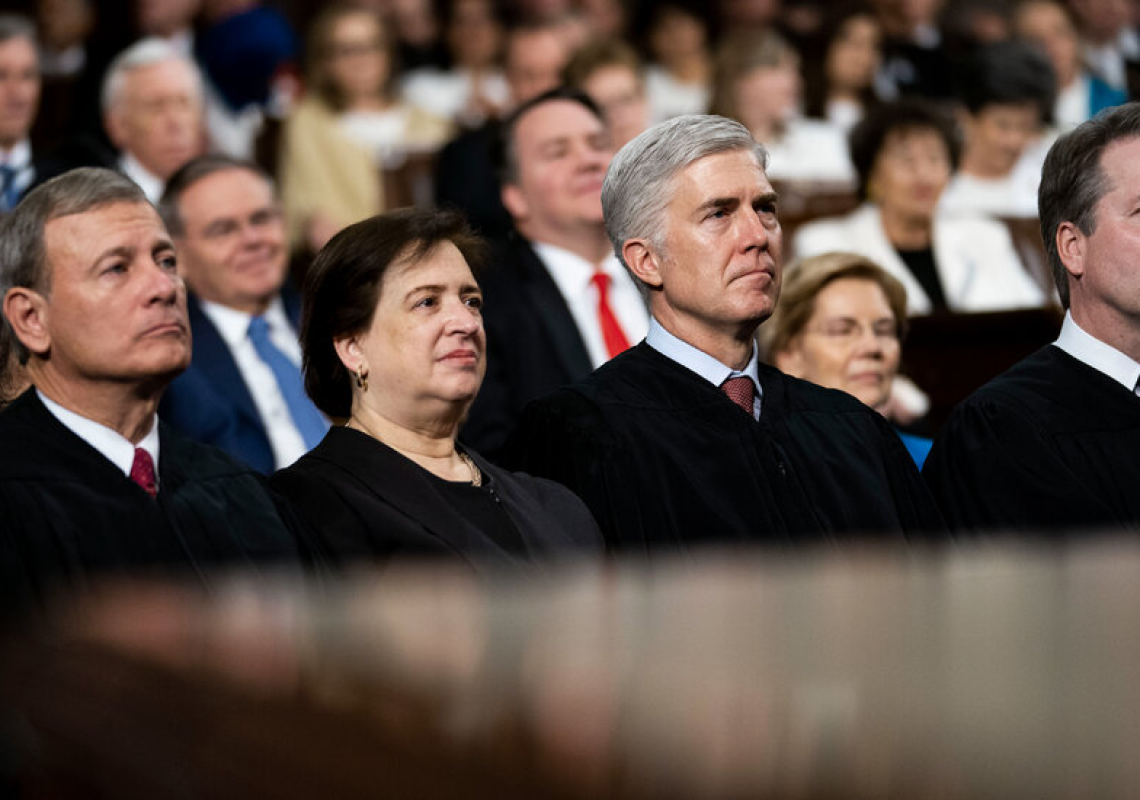Advertisement
Supported by
The Morning Newsletter
The Supreme Court may reconsider a major case concerning freedom of the press. The Times’s Adam Liptak explains why.
Send any friend a story
As a subscriber, you have 10 gift articles to give each month. Anyone can read what you share.
By Adam Liptak
Four years ago, at his Supreme Court confirmation hearings, Justice Neil M. Gorsuch indicated that a 1964 precedent protecting press freedom was secure. “That’s been the law of the land for, gosh, 50, 60 years,” he said of the decision, New York Times v. Sullivan, which made it very hard for government officials to win libel suits.
But last month, Gorsuch said it was time for the Supreme Court to take another look at the case. “What started in 1964 with a decision to tolerate the occasional falsehood to ensure robust reporting by a comparative handful of print and broadcast outlets,” he wrote in a dissenting opinion, “has evolved into an ironclad subsidy for the publication of falsehoods by means and on a scale previously unimaginable.”
He is not alone in calling for reconsideration of the decision, which has only one rival as the most important legal triumph for the press in American history, also involving The Times, the Pentagon Papers decision in 1971. Justice Clarence Thomas, for instance, has repeatedly called for the Supreme Court to reconsider Sullivan and rulings extending it, saying they were “policy-driven decisions masquerading as constitutional law.”
In March, Judge Laurence H. Silberman of the U.S. Court of Appeals for the District of Columbia Circuit endorsed that view in a dissent but said that overturning Sullivan would be a heavy lift. “I recognize how difficult it will be to persuade the Supreme Court to overrule such a ‘landmark’ decision,” he wrote. “After all, doing so would incur the wrath of press and media.”
The press is biased, he wrote, and so does not deserve Sullivan’s protections. “Two of the three most influential papers (at least historically), The New York Times and The Washington Post, are virtually Democratic Party broadsheets,” Silberman wrote. “And the news section of The Wall Street Journal leans in the same direction.”
There are echoes of Donald Trump’s frustration with modern defamation law in some of these critiques.
“We’re going to open up those libel laws,” Trump said on the campaign trail in 2016. “So when The New York Times writes a hit piece which is a total disgrace or when The Washington Post, which is there for other reasons, writes a hit piece, we can sue them and win money instead of having no chance of winning because they’re totally protected.”
It is certainly true that Sullivan imposed a daunting standard, one that favors free speech over protecting reputation. It requires proof that the disputed statements were made with “actual malice” — that is, with knowledge of their falsity or with serious subjective doubts about their truth.
The Sullivan decision was limited to public officials. Later decisions required “public figures” — celebrities and people caught up in public controversies — to make the same showing.
In a 1993 book review, Justice Elena Kagan, then a law professor at the University of Chicago, said those were “questionable extensions.”
“In extending Sullivan,” she wrote, “the court increasingly lost contact with the case’s premises and principles.”
In his recent dissent, Gorsuch cited Kagan’s article, twice, making a similar point. “Rules intended to ensure a robust debate over actions taken by high public officials carrying out the public’s business,” he wrote, “increasingly seem to leave even ordinary Americans without recourse for grievous defamation.”
But the debate over the proper scope of the Sullivan rule is no reason to do away with it, said RonNell Andersen Jones, a law professor at the University of Utah.
“There is a reason that Donald Trump and other politicians hate the Sullivan standard so much,” she said. “It is a key way that we make sure that government officials and other people in power can’t silence their critics. It would be a massive blow to American-style free speech to lose it.”
Adam Liptak is the Supreme Court reporter for The Times.
Evacuation flights sped up, with more American troops securing Kabul’s international airport. Pentagon officials said 5,000 to 9,000 passengers could eventually depart each day.
The Taliban urged Afghans not to leave the country, promising an “inclusive government” without “prejudice” against women. In the city of Jalalabad, however, their fighters responded to public dissent by firing into a crowd and beating protesters.
Here’s a look at Taliban’s leadership.
The Air Force is investigating the toll of Monday’s airport chaos after body parts were found in the wheel well of a military plane. More deaths were reported yesterday.
U.S. intelligence agencies warned over the summer that Afghan forces could rapidly collapse, even as President Biden publicly said a total Taliban takeover was unlikely.
“This is real for us”: Afghans living in the U.S. are watching the takeover with horror.
Gov. Greg Abbott of Texas said he had tested positive for Covid.
“An act of love”: Pope Francis called on people to get vaccinated in a new public service ad.
The Atlanta Falcons became the first N.F.L. team to vaccinate all its players.
The death toll from the earthquake that struck Haiti last weekend has passed 1,900. These maps and photos show the devastation.
Amazon eclipsed Walmart to become the largest retail seller outside China, highlighting the shift to online shopping.
Black homeownership has declined in the past 20 years, hindered by gentrification and inequitable lending policies.
The world’s oldest bank, Banca Monte dei Paschi di Siena, faces a takeover after a test by regulators found that it was also Europe’s weakest lender.
The future Afghan women and girls were promised is in danger of slipping away. But it’s not too late to help them, Malala Yousafzai, the activist and Nobel laureate, writes in The Times.
How worried should you be about inflation? These 179 charts offer a clue.
#LoveWhereYouWork: Twitter hired an executive to promote diversity and toughen up its culture. Then the problems began.
Whodunit: For years, a mysterious figure stole buzzy books before their release. Vulture investigates.
Advice from Wirecutter: Here’s how to save space in your kitchen.
Lives Lived: Maki Kaji said he “fell in love” with a game called Number Place in 1984. He renamed it Sudoku, which roughly translates to “single numbers” in Japanese, and turned it into a global phenomenon. Kaji died at 69.
Perched by a harbor in Asaa, a Danish village with fewer than 1,200 residents, is a statue of a mermaid that resembles a more famous one in Copenhagen. For the heirs of Edvard Eriksen — the artist who sculpted the Copenhagen landmark — the Asaa mermaid is too similar. They began legal proceedings demanding that it be torn down, and that they receive financial compensation.
Where Copenhagen’s mermaid is bronze, Asaa’s is carved from granite. The Asaa mermaid is also plumper, with coarser facial features, though her posture is the same. “How else is she going to sit?” asked Mikael Klitgaard, the mayor of the municipality that includes Asaa. “She’s a mermaid. You can’t put her in a chair.”
The Eriksen estate has a history of lawsuits over images of the sculpture, though its copyright will expire in 2029, as Lisa Abend reports in The Times. Eriksen’s heirs recently sued a Danish newspaper after it published a cartoon of a zombified mermaid and a photograph of the sculpture wearing a mask. A court fined the newspaper for about $45,000.
This time, the estate is seeking $6,000 in compensation. “If ours was bronze, with the same height and face: OK. But they are quite different. Besides, it’s clear she’s local,” Klitgaard said with a wink. “She looks just like an Asaa girl.”
Try coconut rice with shrimp and corn, a summery one-pot dish.
In her new memoir, “All In,” Billie Jean King is as concerned with political and social issues as she is with tennis.
The actress Maggie Q lists her favorite things.
The hosts discussed coronavirus booster shots.
The pangrams from yesterday’s Spelling Bee were biplane and plebeian. Here is today’s puzzle — or you can play online.
Here’s today’s Mini Crossword, and a clue: “Same here” (five letters).
If you’re in the mood to play more, find all our games here.
Thanks for spending part of your morning with The Times. See you tomorrow.
P.S. A fight between the writers Ernest Hemingway and Max Eastman ended up in The Times 84 years ago this month. Hemingway said he had slapped Eastman, who claimed to have thrown Hemingway over a desk.
Here’s today’s print front page.
“The Daily” is about the Haiti earthquake. On “The Argument,” a debate over teaching about racism.
Isabella Kwai, Ian Prasad Philbrick, Tom Wright-Piersanti and Sanam Yar contributed to The Morning. You can reach the team at themorning@nytimes.com.
Sign up here to get this newsletter in your inbox.
Advertisement






